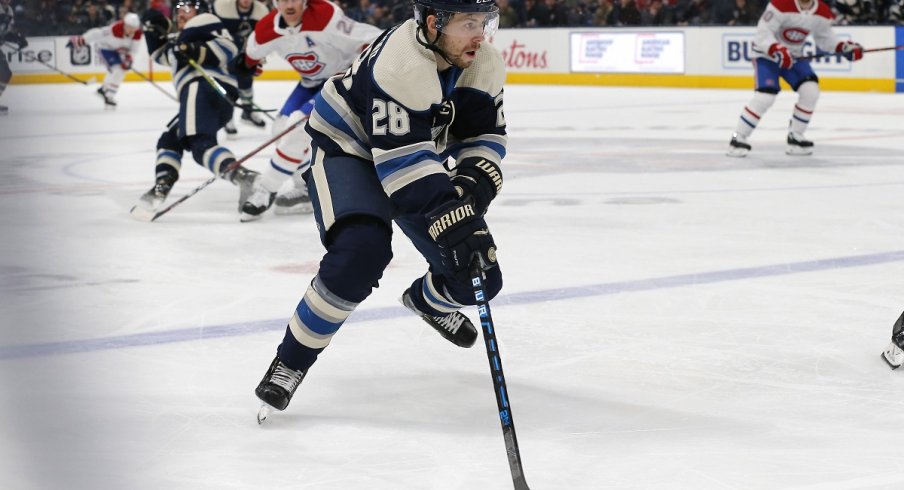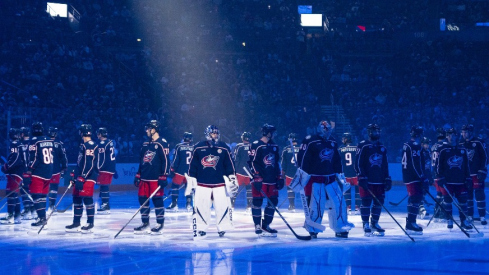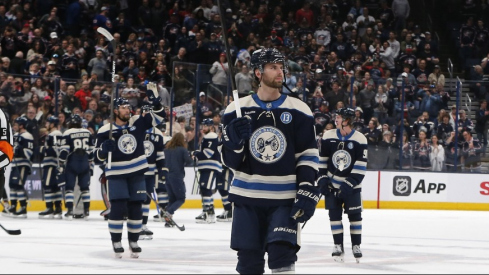Welcome to part two of our State of the Union miniseries, in which we dive deep into the Columbus Blue Jackets' organizational structure in terms of both the present and the future of the franchise. In part one, we explored centers.
Next up, we examine the state of the Blue Jackets' wingers.
Why Wingers Live The Good Life
Wingers and centers are akin to rectangles and squares. Many centermen, being gifted skaters and responsible thinkers, can easily make the move to the wing. The same cannot always be said of wingers making the jump to center.
In an NHL defensive zone, the standard practice is that wingers play a zone. The strong side (same side as the puck) winger will typically stay near the top of the dot, able to help his defensemen in a pinch but also be able to absorb the opposition's defensemen at the point should the puck go low-to-high. The weak-side winger protects and back-door play and is lower in the slot in front of the net. Compared to centers and defensemen, that's a relatively straightforward gig.
This isn't to besmirch the good name of wingers. Some of the best players in the NHL, like Alexander Ovechkin, Artemi Panarin, Mikko Rantanen, Nikita Kucherov, Patrick Kane, and Mitch Marner play on the wing. And nobody would say that wingers have it easy out there on the ice - but most would say that, in a vacuum, they have it easier than centers.
Organizational Depth: Confirmed
Even after Panarin left last July, the Blue Jackets were comfortable with their winger group, led by Cam Atkinson, Oliver Bjorkstrand, Josh Anderson, and the arrival of UFA Gus Nyquist. Atkinson (41 goals), Anderson (27), and Bjorkstrand (23) were coming off career-high goal-totals, while Nyquist was leaving Detroit/San Jose after a career-best 60 points. All four players seemed primed to match, if not increase, their totals, given their increased stature on the team.
Then came the injuries.
The Blue Jackets saw arguably more improvement from the winger position than any other individual position in 2019-20. The sheer volume of injuries to the team allowed forced the organization to dig deep into their AHL pockets in an attempt to an ice a competitive NHL team.
Injuries to key wingers, like Bjorkstrand, Atkinson, Anderson, and rookie Emil Bemstrom gave rise to players most Blue Jackets' fans wouldn't have expected to see in Columbus, primarily Nathan Gerbe, Stefan Matteau, and Jakob Lilja, but also limited showings of Ryan MacInnis, Kole Sherwood, and even Liam Foudy (Note: Bjorkstrand and Bemstrom, in particular, made significant strides this season, and if they were a stock, we would offer a 'buy' rating). The club's seemingly ceaseless options pushed Sonny Milano further down the depth chart, ultimately making him expendable in a trade for Devin Shore, a center who can also play on the wing.
As I mentioned in the center SOTU, Boone Jenner is best served as a winger. But he isn't alone in terms of a player being asked to play somewhere outside of their comfort zone. Alexandre Texier, before he was injured, played primarily on the wing. Kevin Stenlund, another natural center, found himself playing the wing at times this season, and his versatility did not go unnoticed. Alexander Wennberg, too, was moved to the wing in the five most recent games before the NHL season was put on pause.
Nick Foligno, who was on pace for a sub-40 point season, is on the back-nine of his career. Still effective in a penalty-killing situation, the captain is best suited for a bottom-six winger role. Then there's 24-year old Eric Robinson, who has borderline elite NHL speed and size to match it. He's proven to be an NHL winger, but anything higher than a 4th line role may be too big an ask for someone who doesn't produce offense at a high rate.
Question Marks Still Remain
The Anderson injuries further complicate an already complicated situation. A pending RFA, Anderson is arbitration-eligible and one year from UFA. Should he wish, he could bully his way to UFA next summer, and there's not much the Blue Jackets could do to prevent him from doing that. Remember the contentious contract negotiations between the Blue Jackets and Anderson's agent Darren Farris? We sure do, and it's difficult to imagine this next round of contract talks being much rosier. A year after Anderson scores 27 goals and is primed to become perhaps the preeminent power forward in the NHL, he aggravates his already-injured shoulder and tallies 1-3-4 over 26 games. How are the two parties going to agree on his value?
Should the Blue Jackets and Anderson/his camp come to a consensus and he is able to return to his pre-injury form, Anderson would be a huge part of this franchise moving forward. But that's a lot of stipulations, and moving Anderson in a trade to ensure that Columbus isn't (again) losing an important UFA in his prime for nothing wouldn't be a shock.
Then there's Brandon Dubinsky, who we last saw in meaningful game action in the 2019 Stanley Cup Playoffs, primarily as a 4LW. Prior to the start of this season, management announced he would be out indefinitely as his wrist healed. It never did. He has one more year on his contract at $5.85M. Who can say whether he plays again in Columbus, but if he does (and it seems less likely as more time passes), it would be shocking to see him higher than in a 4LW role.
Should the season resume this summer, Bjorkstrand, Atkinson, and Texier would all return to the lineup, whereas Anderson appears to be more a question mark.
Future Projections
Looking ahead to 2020-21 and beyond, the center depth chart could be Pierre-Luc Dubois, Texier, Foudy, and Stenlund. But as mentioned above, the latter three could all move to the wing if it's deemed that the responsibility associated with playing center is too rich for their blood. That would allow any or all of Jenner, Wennberg, and Riley Nash to return to center. Let's continue this hypothetical projection by assuming all of the youngsters take hold of the center spots available. That could leave winger pairs like the below:
F1 - Nyquist - Atkinson
F2 - Bemstrom - Bjorkstrand
F3 - Jenner - Anderson
F4 - Wennberg - Foligno
That would make for difficult decisions surrounding Eric Robinson, Nathan Gerbe, Riley Nash, and would effectively demote players like Matteau, Lilja, and Shore.
Could Columbus, who clearly has a surplus of NHL wingers (what a nice problem to have), move one or more of them for help at center, or as a way to upgrade on the top half of their lineup at LW? I think it's a more than plausible scenario.
The Blue Jackets have some interesting prospects in the pipeline, but with so few draft picks in recent years (they had just three in 2019), the cupboard is relatively bare. Namely, Kirill Marchenko is a name to remember. The 19-year old had an impressive rookie season in the KHL, posing 7-9-16 in 31 games with SKA St. Petersburg. The former second-round pick is seen as someone who has top-line talent, and The Athletic's Aaron Portzline's recent article compared him to the Nashville Predators' Filip Forsberg.
The Blue Jackets are also excited about Trey Fix-Wolansky, a former seventh-round pick who, after battling injury woes, posted 12-14-26 in 43 games with AHL Cleveland. Between the late-round status and his 5'6 stature, the odds are against him, but at age 20, he has time to prove otherwise.
Conclusion
Unlike center, the Blue Jackets are flush at the winger position. Like center, the organization lacks elite talent at the top of the lineup. While Bjorkstrand, Atkinson, Anderson, and Nyquist are all bonafide top-six players, the organization will surely look to do everything in its power to upgrade from a position of quality.


